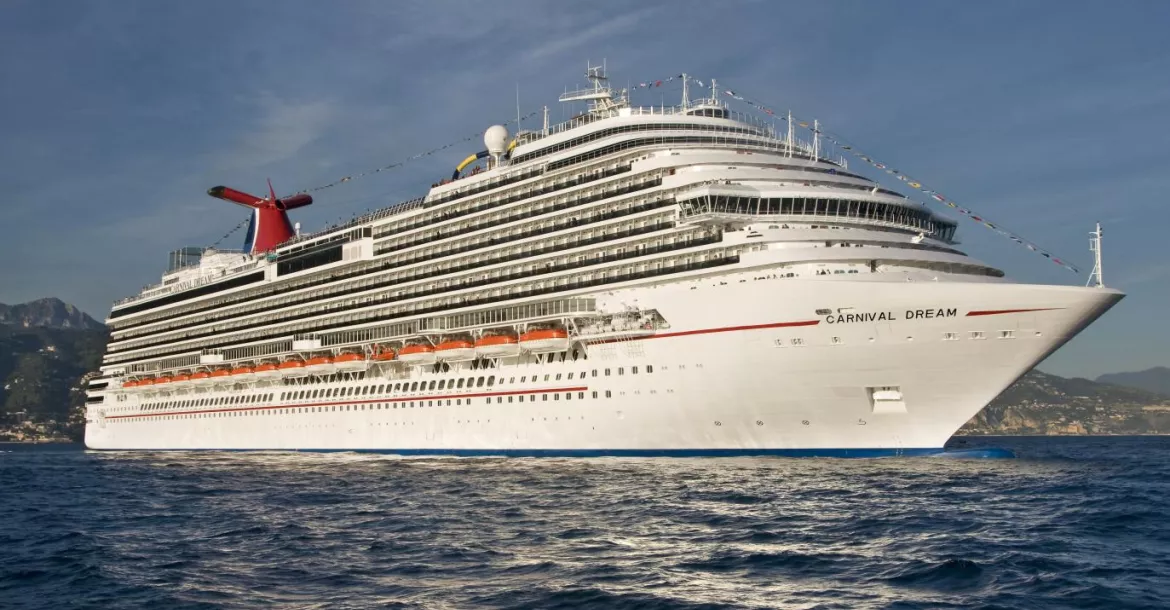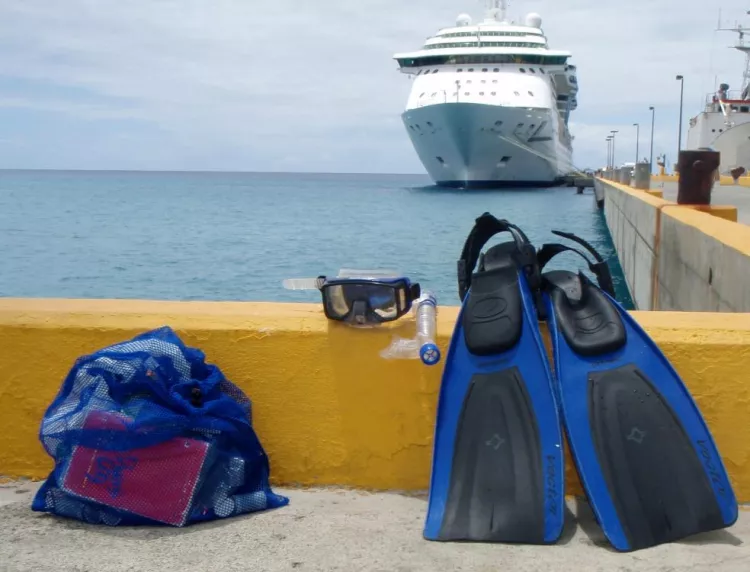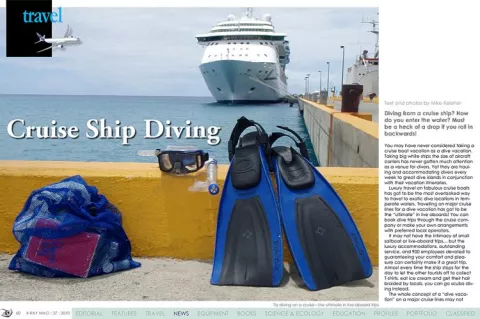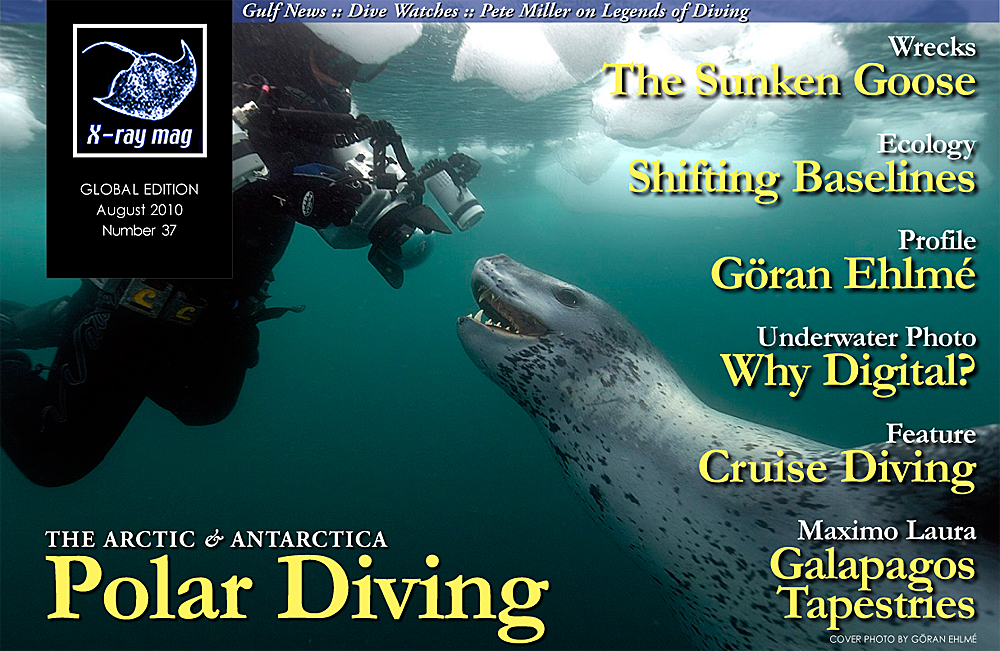Diving from a cruise ship? How do you enter the water? Must be a heck of a drop if you roll in backwards!
Contributed by
Luxury travel on fabulous cruise boats has got to be the most overlooked way to travel to exotic dive locations in temperate waters. Travelling on major cruise lines for a dive vacation has got to be the “ultimate” in live aboards! You can book dive trips through the cruise company or make your own arrangements with preferred local operators.
It may not have the intimacy of small sailboat or live-aboard trips… but the luxury accommodations, outstanding service, and 900 employees devoted to guaranteeing your comfort and pleasure can certainly make it a great trip. Almost every time the ship stops for the day to let the other tourists off to collect T-shirts, eat ice cream and get their hair braided by locals, you can go scuba diving instead.
The whole concept of a “dive vacation” on a major cruise lines may not compute, but they have quietly been putting divers in the water every week for many years. On a seven day vacation cruise, the big ships stop at three to five islands in the Caribbean, Mexico and Hawaii, and most are prime dive sites. The cruise lines offer excursions directly through their company for SCUBA (to include full equipment rental) and many other water-related activities like snorkeling, SNUBA and an underwater scooter with a big bubble helmet called Breathing Observation Bubble (BOB).
Benefits
For me, the terms “adventure travel” and “diving” usually conjure up thoughts like, “Am I going to get a clean place to sleep,” and “I hope I can find some good food along the way”. Traveling on a major cruise boat pretty much eliminates those worries! Very reasonably priced accommodations allow you to travel in obvious comfort and elegance. They deliver you on-time to a different island each day, feed you 24 hours a day, and entertain you at night.
With your own cabin stewards, droves of waiters and over one hundred cooks on board, they treat you like royalty a week at a time—what more could you ask for? Ah yes, let‘s not overlook the obvious here—if we are around that much warm water in a foreign and exotic locale, we naturally are going to want to dive in it.
Major cruise lines like Royal Caribbean, Celebrity, Holland America and Carnival among others, are taking divers to great dive locations every week of the year without much notice or fanfare. They are obviously not advertising as traditional “liveaboards” or “all inclusive resorts” and are not directly competing with such operations for divers. However, they do offer a unique and non-traditional way to get to dive locations in comfort—very cushy comfort at that!
Features
If you have not been on a cruise ship, you may be surprised to find many of the large ships have actual “dive shops” on board (along with the rock climbing walls, in-line skate tracks, surfing wave pools and ice skating rinks—yes, ice skating). The on-board dive shop has several functions to benefit guests who wish to dive. They arrange excursions for dive trips at pre-designated islands, may sell a limited amount of gear on-board, and have an in-house Dive Master to shepherd the “cruise divers” to various pick up sites or in-water excursions.
The larger ships that offer diving excursions may also offer unique on-board certification training for guests who want to get certified en route to the dives sites. The book work and pool work is actually done on the ship while it is at sea. They then arrange check-out dives with a traditional dive shop on one of the various islands they visit.
On that day, the guests are picked up, taken to the dive shop, complete the in-water portion in the warm blue Caribbean, or off the coast of Hawaii or Mexico...instead of back home in a rock quarry in the Midwest….or in one of the Great Lakes!
Dive sites
The list of islands and dive sites where scuba excursions are offered are well known in the dive community. The routine cruise boat itineraries hit islands and locations like George Town in Grand Cayman, Costa Maya and Cozumel in Mexico, Key West and Fort Lauderdale in Florida, the Bahamas, Charlotte Amalie in St. Thomas, Philipsburg in St. Maarten, Montego Bay in Jamaica, San Juan in Puerto Rico, St. Johns in Antigua, Basseterre in St. Kitts, Castries in St. Lucia, Bridgetown in Barbados, Margarita Island in Venezuela, Willemstad in Curacao, Oranjestad in Aruba and the Hawaiian islands.
Hey, those destinations sound pretty familiar! Cruise lines arrive at those cities each week and contract with reputable dive shops to take their guests for two tank dives.
One of the strengths in booking dives via the cruise boat is the fact the cruise companies hold the local dive operators to the same level of mega customer service as provided on board the ship. If customers are not treated well, the cruise lines will quickly find a new partner willing to accept guaranteed money from 20-30 divers delivered to their doorstep several times a week.
Much like the rest of cruise boat vacations, the company takes a lot of the worry out of making dive arrangements. If one of their contracted dive operators has a problem getting you back to the ship, the cruise line will take responsibility for you and getting you back on board or keeping the ship in port until they recover all passengers.
If that happens with an excursion you booked on your own, you may just be standing on the dock watching the big white ship with your entire luggage and all that food sail away while you wonder how to get home or to the next island! (Although cruise lines have staff reps at each destination that can help guests make arrangements to catch up with the boat).
Experienced Cruise Boat Vacationer Note: When the cruise line says be back on board at 5 PM…they mean it! It’s quite an impressive sight to be on deck during a departure and watch for late arriving shipmates. Most vacationers really enjoy seeing a couple loaded down with t-shirts and drunken gringo hats sprinting down the dock only to skid to a stop after the gang plank is up.
Be sure to point and wave politely at those people as you steam out of the harbor. They will catch up at the next port, but whoo-boy, will there be some angry inter-couple conversations about “whose fault” it is that they missed the boat.
Special arrangements
If you have a preferred dive operation at a certain island, you are of course free to make your own reservations in advance. I have found the operators are quite willing to pick you and your gear up pier side and work within your ship’s port time parameters for half day or all day trips.
My “adventure wife” prefers making these types of reservations via the internet and telephone, and they have worked out well. You can get a lot of information in advance from the dive operators directly, vice booking through the cruise line with an operator you won’t know until you are pier side with your borrowed boat towel and gear in hand.
One of the other benefits of pre-arranged private bookings is that you can insure you will not be subjected to cattle-boat/mass-tourist diving and snorkeling trips. Cruise boat booked excursions may end up being a big boat combining snorkelers and divers that dump 30-40 snorkelers in the same location with the eight or ten divers. Kind of luck of the draw there, and you won’t know until you are on the big boat how they run their trips.
(Nothing against snorkeling... I hope we as divers all still look kindly upon snorkelers, and may still dabble ourselves… if compressed air is not available).
Most of the private dive bookings we have made ended up with 2-6 divers and very attentive staff/operators who can lavish me with attention instead of having to deal with first time snorkelers…
Having booked through the cruise lines and private operators, we find the private bookings are usually cheaper by US$10-20 dollars, and we get very good service with the smaller companies. Caribbean dive prices routinely run US$100-130 including full rental gear for a half day two-tank dive. Taking your own gear can knock US$10-20 off the price of the dive.
To bring or not to bring gear
We usually haul our full gear along on cruise/dive vacations with a wheeled bag to get on and off the piers. It adds about 50 lbs of gear for two people, and you have the comfort of using your own gear, and post dive, you can clean it in your cabin shower, and then drape it attractively about your cabin and/or balcony where the cabin steward can admire it while making up your room three times a day.
This year, with airlines charging extra baggage prices for checked luggage, and the considerable extra bulk of BCD’s, regulators/computers, wet suits, etc, I finally decided to leave everything except mask, fins and snorkel at home for a 7-day cruise.
Conceptually, it was hard for me at first, but paying the extra US$10-20 to the dive shop for full gear rental turned out quite well. I was very pleased with the quality of the rental gear, and the dive operators even threw in shorty wet suits for us at each location for free.
The rental equipment all worked well. Plus, I got an unexpected benefit of getting to wear a lot of different manufacturers’ gear day after day and making my own comparisons. It was also very nice to hand it all back at the end of the dive for them to maintain, while I just walked away with a net bag of fins/mask and snorkel.
Lessons learned
On this particular trip, the ship stopped at five different islands, and we pre-booked with private operators via the internet and telephone in St Croix, St Kitts and Barbados and unsuccessfully tried to book another island dive via the cruise ship once we were on board—since we could not get an operator on the island to respond to us via email. You can pre-book ship excursions from home and it turned out the ship’s 10 or 12 slots had all been reserved well in advance of the sailing. So live and learn—book early!
We have also learned one other booking trick associated with cruising. If you have not made reservations ahead of time, or the ship trips are already booked, you may still have a last minute chance to dive once the ship arrives at a suitable island.
Local tour operators of all descriptions will be waiting on cruise boat piers hoping to get tourist dollars for historical tours, ATV and Jeep rides, jungle excursions, zip-lines, beaches, party boats, snorkeling and even scuba diving. If you have a C card in your pocket, someone will route you to a dive operation.
These last minute deals are generally cheaper than pre-arranged trips, and you may have some haggling leeway, but it is balanced against the fact that your ship visit will only last six to eight hours, and any diving has to fit within those parameters. Not my favorite way to book a dive, but is an option if everything else fails.
My adventure wife and I have been diving from cruise boats for a number of years and enjoy the opportunity to see so many different dive islands and dive locations in a week’s trip. It is not the same as getting to spend a solid week on one island diving every day, but it is kind of a scuba sampler platter, and helps us look for places we would like to return for a more extended stay, as well as meet some great dive operators we would do business with again.
All of this diving, surrounded by absolute luxury accommodations, top knot service, unbelievable food and nightly entertainment at about US$100 a day per person on the ship (excursions and drinks are extra)… what’s not to like?
If you have a non-diving spouse or partner, it is a very enticing way to have a very nice vacation and get you into dive togs with no muss or fuss, and you definitely dominate the formal dining table discussions with answers to the nightly question: “So, what did you do today on the island?” ■





























